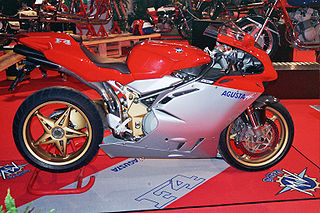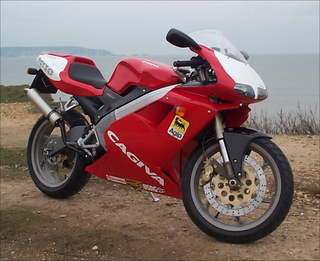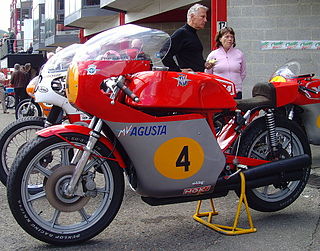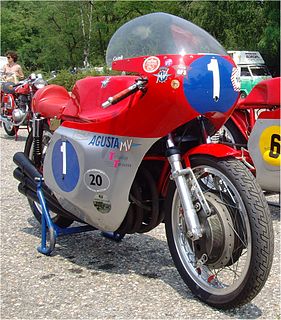
MV Agusta is a motorcycle manufacturer founded by Count Domenico Agusta on 19 January 1945 as one of the branches of the Agusta aircraft company near Milan in Cascina Costa, Italy. The abbreviation MV stands for Meccanica (mechanics) Verghera, the hamlet where the first MVs were made. The modern headquarters and main production facilities are located in Varese, Italy on the shore of Lake Varese.

The MV Agusta F4 is a four-cylinder sport bike made by MV Agusta from 1999 until 2018. It was the motorcycle that launched the resurrection of the brand in 1998. The F4 was created by motorcycle designer Massimo Tamburini at CRC, following his work on the Ducati 916. The F4 has a single-sided swingarm, large diameter front forks and traditional MV Agusta red and silver livery. The F4 engine is also one of the few production superbikes to have a hemi-spherical cylinder head chamber design with 4 valves per cylinder.

The MV Agusta Brutale series of motorcycles are manufactured by MV Agusta of Italy, starting in 2001. Its style is classified as a naked bike and the series consists of several models powered by either inline-four or inline-three, DOHC-engines in various capacities.

The next new Ducati engine to appear after the Ducati Apollo was the 90° V-twin, initial Grand Prix racing versions being 500 cc, and the production bikes were 750 cc. There was also the Ducati 750 Imola Desmo that won at Imola in 1972. These engines had bevel gear shaft drive to the overhead camshaft, and were produced in round, square, and Mille crankcases. In the 1980s, these gave way to the belt drive camshaft engines that have continued to this day, in air-cooled and liquid-cooled form. The Mille used a plain bearing crank, like the belt models.

The Cagiva Mito is a small-engined Cagiva sports motorcycle. The powerplant consists of a two-stroke 125 cubic centimetres (7.6 cu in) single-cylinder engine.

The MV Agusta 750 Sport America was a motorcycle manufactured by the MV Agusta company from 1975 to 1977. Derivative models were produced in limited numbers until 1982, and the Magni models are still available to special order.

The MV Agusta 600, also called the MV Agusta 600 4C and the MV Agusta 600 Turismo, was a motorcycle built by the MV Agusta company from 1966 to 1970. For the first time, a four-cylinder engine was fitted transversely to the direction of travel on a standard motorbike and cable-operated disc brakes were used. A total of 135 of this model were manufactured.

The MV Agusta 500cc road racers were motorcycles that the manufacturer MV Agusta built and which were used to compete in 500cc Grand Prix motorcycle racing series between 1950 and 1976. 18 500cc world championship titles were achieved with these machines ridden by John Surtees, Gary Hocking, Mike Hailwood, Giacomo Agostini and Phil Read between 1958 and 1974.

The MV Agusta 500 four-cylinder (1973-1976) was a racing motorcycle manufactured by the Italian company MV Agusta, for competing in the 500 cc series, the premier class of the FIM World Motorcycle Championship. With this motorcycle MV Agusta won the 1973 constructor's world champion and Phil Read won the 1973 and 1974 500 cc riders world championships.

The MV Agusta 350 6 cilindri was a prototype racing motorcycle built by the Varese company MV Agusta in 1957, for the 350 cc class of the FIM Motorcycle World Championship. The project was resurrected in 1968. Neither version was ever used in a race. The only surviving model is now in the MV Agusta factory museum.
The MV Agusta 250 Monocilindrica Bialbero was a 250 cc factory racer manufactured by the Italian brand MV Agusta from 1956 to 1959. With this machine 15 GPs, 2 Driver Championships and 2 manufacturers World Championships were won.
The MV Agusta 250 Bicilindrica was a 250 cc factory racing motorcycle manufactured by the Italian brand MV Agusta from 1957 to 1961. With this machine 11 GPs, 2 Driver Championships and 2 manufacturers World Championships were won.
The MV Agusta 203 Bialbero and MV Agusta 220 Bialbero were Italian factory racing motorcycles made by MV Agusta to compete in the 1955 250 cc World Motorcycle Racing Championship. The machine won three GPs and with it MV Agusta won that year's 250 cc Constructors Championship.

The MV Agusta 125 Bialbero was a 125 cc factory racer from the Italian brand MV Agusta, which was used between 1950 and 1960. The machine won 34 GPs, 6 rider's championships and one manufacturer's championship. The machine also won 4 Italian Championships and 10 National Championships in other countries.

The MV Agusta 125 Pullman was a motorcycle produced by the Italian manufacturer MV Agusta from 1953 to 1956. The model achieved a good sales success, and had the highest production of any machine from MV Agusta. Many brought the bike as the only means of family transport or as a work vehicle. Despite the questionable aesthetics, the Pullman offered a comfortable ride, derived by the driving position, soft suspension and large section tires. This was particularly appreciated by users, so much so that they were imitated by some competitors. 27,000 machines of this model series were produced. The model was also produced under licence in Spain by Avello, where it was marketed as the MV Avello 125 Pullman Turismo.
Piero Remor was an Italian engineer and motorcycle constructor, best known for his work for the Gilera and MV Agusta brands.

The MV Agusta F3 is a series of motorcycles introduced in 2012 by the Italian manufacturer MV Agusta. These models are the first three-cylinder machines that MV Agusta have manufactured since the famous three-cylinder GP racers of the 1970s.

The MV Agusta 125 Sport SE was a sport motorcycle built from 1975 to 1977 by the Italian manufacturer MV Agusta. It was one of the last models to be produced by Meccanica Verghera at their Cascina Costa plant.

The MV Agusta 150 Sport RS was a motorcycle produced by the Italian motorcycle MV Agusta in their Cascina Costa plant from 1959 to 1969.
The MV Agusta 250B (Bicilindrica) was a motorcycle produced by the Italian manufacturer MV Agusta from 1968 to 1971. The motorcycle was first introduced at the 1965 Milan EICMA motorcycle show and was based on the stilborn MV 166 Arno GT. The model was discontinued in 1971 following the introduction of an overbored version, the 350B.














